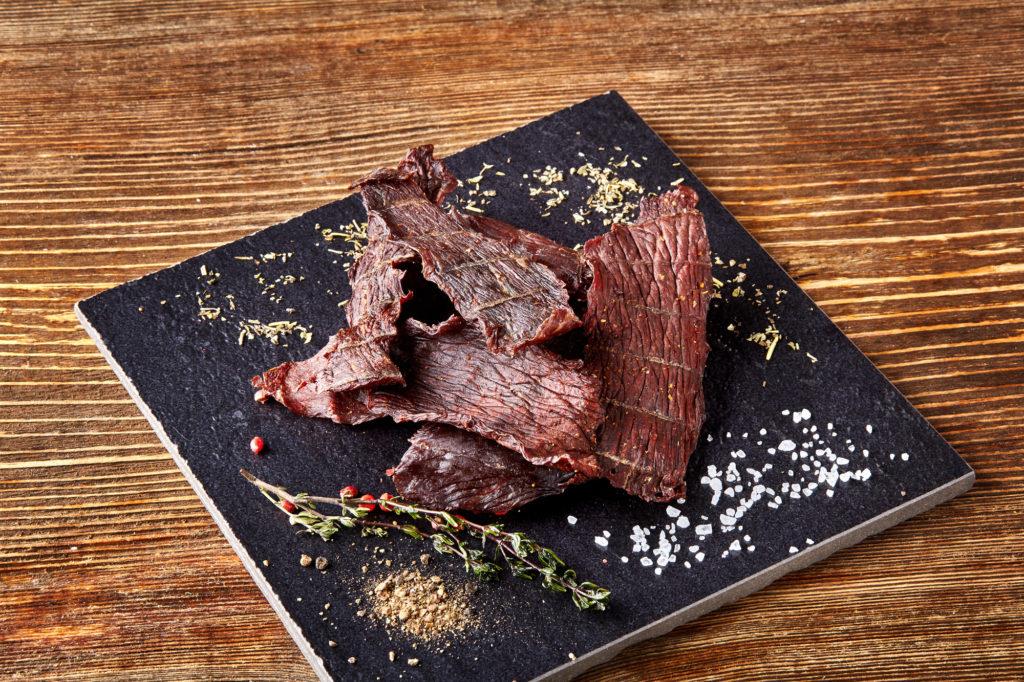
There’s something rugged and natural about eating beef jerky; it feels like you’re channeling an earlier time when innovation didn’t involve refrigerators. Plus, it fits most of today’s diet trends, from keto to paleo. There’s a problem, though: the price tag.
Americans spend about $2.8 billion on jerky and other meat snacks each year, with a pound of jerky running over $20 in most stores. How can you enjoy a cowboy’s snack without a highfalutin city slicker’s budget? Make your own.
It may sound daunting, but learning how to make beef jerky is easier than you might think. Here are the simple steps:
How to Make Beef Jerky at Home
If you’re ready to venture into the wonderful world of jerky-making, here are the steps to follow:
1. Choose and Purchase Your Beef
You could say the same with most meat dishes, but with beef jerky, the meat is the crux of the end result. The cut you choose is a vital part of the process.
As you shop for your beef, the key is to find the leanest cut out there. Fat doesn’t offer a great taste or texture when you try to dehydrate it. It will also make the jerky spoil at a faster rate.
As you experiment with several batches of jerky, you’ll find the cuts you enjoy most. However, the best cuts to start with tend to be the eye of round, bottom round, and top round. Keep in mind that you can ask your butcher to cut off as much of the fat as possible.
It’s also important to know how much beef to buy. When you dehydrate the meat, it will lose about two-thirds of its weight. That means that if you want to end up with one pound of jerky, you should buy three pounds of beef.
2. Choose Your Flavor
When you buy beef jerky in a store, you’ll see a wide selection of flavors. Plus, you can have any flavor you want when you make your own jerky.
Choose a more plain, basic marinade or go for a more adventurous flavor profile like barbecue or Korean style. If you have a favorite steak marinade, that may be a good place to start. As you make more batches, though, you can experiment with various marinade recipes.
3. Slice the Beef
Before you start slicing your beef into strips, there are a few things you need to know. First, remember all those problems that fat can cause? Start by cutting away as much of the visible fat as you can.
Next, you need to choose which way to slice the beef. Depending on whether you slice with the grain or against the grain, you’ll end up with different results.
The “grain” of beef is the direction in which the fibers are running. If you cut with the grain, your jerky will be tough and chewy. If you cut against the grain, the jerky will be softer.
Over a few batches, you can experiment with different cutting techniques to see what you like best. However, there’s a way to get a happy medium between soft and chewy. You’ll cut the beef with the grain, but then use a metal or wooden meat tenderizer to soften it.
No matter what method you choose, you’ll want to slice the beef into strips that are about 1/4 of an inch thick. They should be about an inch wide and as long or short as you want.
If the meat isn’t firm enough for you to slice with ease, there’s an easy fix. Wrap it in a freezer bag or plastic wrap and put it in the freezer for about an hour.
4. Marinate the Beef
Now that you’ve prepared the beef, it’s time to let it soak up some sweet flavor. Mix up any marinade you choose based on what flavor you want.
Add the beef strips and let them sit in the marinade in the refrigerator. Depending on how deep you want the flavor to be, you can marinade the beef for anywhere between a few hours and a full day.
5. Prepare the Oven
There are a few different ways to dehydrate your jerky in the oven. Some people prefer to put the beef strips right on the oven racks. If that’s what you choose. you’ll want to put foil on the bottom of your oven to catch any dripping.
Even with the foil, though, that method can be messy. If you prefer, you can put foil on a baking sheet. Place a wire rack on top of this sheet so that the beef strips won’t lay on the foil.
As you prepare your dehydrating scene, preheat your oven to 170 degrees. Don’t try to rush the process by using a higher heat. This will make your beef instead of drying it, and it won’t be that great jerky you’re aiming for.
6. Dry the Beef in the Oven
When the jerky has marinated for as long as you’ve chosen and the oven is ready, take the beef strips out of the fridge. Some jerky fans choose to pat the strips dry, but it’s a matter of personal preference.
Regardless, place the strips on your wire rack or oven rack. Make sure none of the strips touch each other and that there’s room for air to circulate on all sides of them.
Put the strips in the oven for about three hours. Flip them and dry them for three hours more. Keep in mind that this is a rough estimate. It depends on how thick your beef is as well as your personal tastes.
To get the right dehydration level, check your jerky every hour or so. You want to be able to tear off a piece, but it shouldn’t be so dry that it breaks if you bend it.
7. Cool the Jerky
When you’ve achieved that perfect level of dryness, remove the jerky and let it cool at room temperature for a few hours. After this time, toss it into an airtight container for storage.
8. Enjoy!
One of the great features of beef jerky is that it stays fresh for a long time. Homemade varieties tend to last about three months in a sealed container at room temperature.
Other Ways to Save on Beef Jerky
Beef jerky is one of those snacks you make once and ask “Why have I been paying for pre-made jerky all these years?” At least that’s what happens in most cases. If you have some serious kitchen challenges, though, maybe you’d still prefer a commercial option.
To find no-assembly-required jerky that fits your budget, follow these tips:
1. Buy in Bulk
As with most grocery items, beef jerky tends to be cheaper when you buy it in bulk. The great shelf life makes it easy to get that quantity discount without wasting food.
Keep in mind that store-bought jerky tends to last longer than homemade jerky. Some varieties can last as long as one or two years if you keep it in the original airtight packaging.
2. Buy Wholesale
If you’re looking for a great deal, wholesale beef jerky may be the way to go. Click here to read more about this option. Most people don’t consider it because they assume only businesses can buy wholesale products.
A common misconception is that buying wholesale and buying in bulk are the same. While wholesale providers do tend to sell in bulk quantities, you’ll get a better price than you would if you bought it from a warehouse store.
3. Hunt for Coupons
If you’re more of an occasional fan and you think bulk packages of jerky would go to waste, you may be able to save at your local grocery store too. There are plenty of places online where you can find coupons from manufacturers or from stores.
Keep in mind that coupons for beef jerky aren’t the most plentiful, but when you find some, you should stock up. It’s also a good idea to keep an eye out for sales and build up your stash while the price is low.
Whatever you do, though, steer clear of vending machine beef jerky. You’ll pay out the nose just because you didn’t plan ahead.
Nailing Your Beef Jerky Game
Learning how to make beef jerky is easy. Learning how to make it well is another story. Practice makes perfect, so don’t get discouraged.
It may take you several batches to get the right flavor, dryness level, cut, and thickness. Take your time and experiment to find your sweet spot.
Remember that one of the best things about beef jerky is that you can try out several options in the same batch. Mix up a few different marinades, cut at a couple of different thicknesses, or experiment in other ways.
To learn about other high-protein snacks and get more healthy living tips, check out our health and wellness blog.

